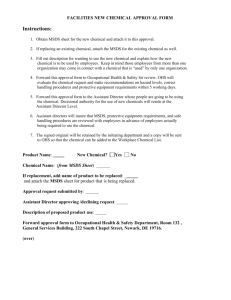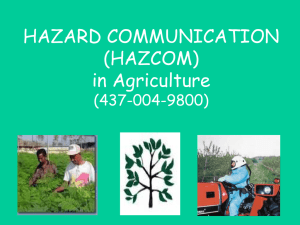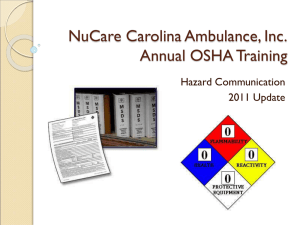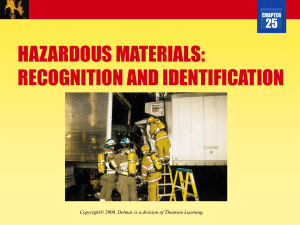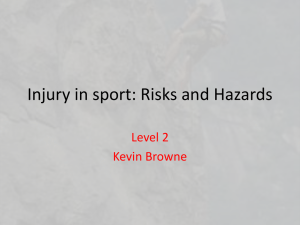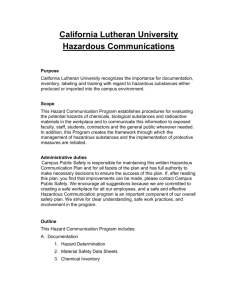Chemical Hazard Communication
advertisement
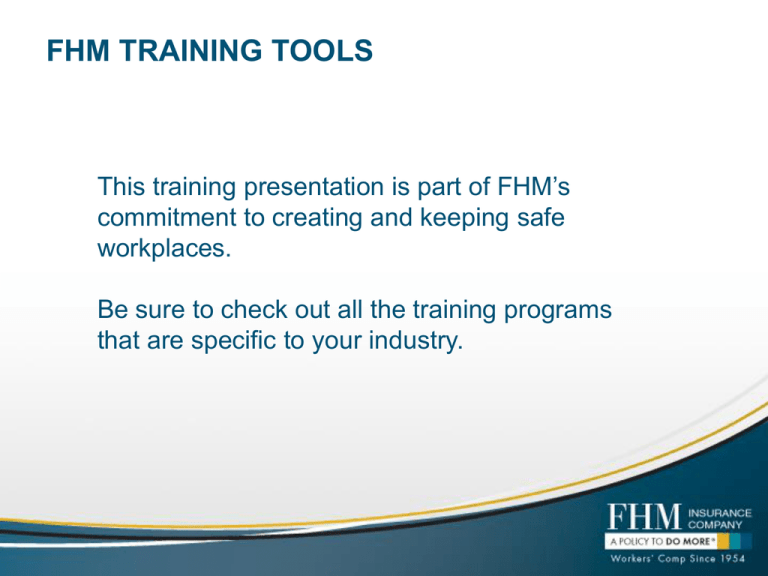
FHM TRAINING TOOLS This training presentation is part of FHM’s commitment to creating and keeping safe workplaces. Be sure to check out all the training programs that are specific to your industry. Hazard Communication for General Industrial Employers ►►► These materials have been developed based on applicable federal laws and regulations in place at the time the materials were created. The program is being provided for educational and informational purposes only and does not constitute and is not intended to provide OSHA compliance certification, regulatory compliance, a substitute for any "hands on“ training required by applicable laws and regulations, or other legal or professional advice or services. By accessing the materials, you assume all responsibility and risk arising from the use of the content contained therein. ©2010 Grainger Safety Services, Inc. Learning Objectives Objectives: ► Recognize hazardous chemicals in the work area ► Identify physical and health hazards ► Identify measures to prevent harmful exposures Agenda Overview: ► Discuss methods to detect chemicals ► Review potential physical and health hazards ► Precautions and protective measures ►Section 1 Overview The Hazard Communication Standard Hazard Communication Standard: ► Provides workers with right to know hazards 32 million workers exposed to hazardous chemicals per OSHA: ► National Institute for Occupational Safety and Health, lists 575,000 hazardous chemical products in workplaces Employer Responsibilities The Hazard Communication Standard established: ► Chemical manufacturers and importers must list hazard information on material safety data sheets Use hazard communication procedures to: ► Inform and train workers ► Establish a chemical inventory ► Retain warning labels ► Provide material safety data sheets Information Provided to Employees Employees must be informed of: ► Hazardous chemicals present in work area ► Location of written hazardous program ► Location of hazardous chemical inventory ► Location of material safety data sheets Employee Training Train employees to determine: ► If chemicals are present ► Potential hazards of chemicals ► Protection from harmful chemicals ►Section 2 Detecting Chemicals in the Workplace Container Labeling Hazardous chemical container labeling: ► Hazardous chemicals must be labeled, tagged, or marked ► Containers are appropriately labeled Four types of containers: ► Primary ► Secondary ► Stationary containers ► Portable containers Primary Containers Primary containers: ► Three elements of information: – Identification – Appropriate hazard warnings – Name and address of chemical manufacturer Secondary Container Term used to distinguish from primary container: ► Container is labeled, tagged, or marked with: – Identification – Contained therein – Appropriate warnings Stationary Containers Stationary process containers: ► Affixing labels required by employer ► Written materials readily accessible Portable Containers Portable containers: ► Transfer chemicals from labeled containers ► For use by employee performing transfer Ways to Detect Chemical Presence Detecting presence of chemicals: ► Perform industrial hygiene surveys ► Monitoring devices to detect: – Gases – Dusts – Vapors ►Section 3 Physical and Chemical Hazards Chemicals Come In a Variety of Forms Hazards chemicals presents: ► Dusts ► Fumes ► Fibers ► Mists ► Vapors ► Gases ► Solids ► Liquids Routes of Entry The four common routes of entry are: ► Ingestion ► Inhalation ► Absorption ► Injection Hazard Types Physical hazards: ► Fire ► Explosion ► Reaction Health hazards: ► Problems range from: – Irritation – Toxic effect – Cancer Acute and Chronic Effects Acute and Chronic effects: ► Acute effect from a single exposure ► Chronic effects from repeated exposures Health Hazard Terms Chemical hazards are described as: ► Toxic ► Carcinogen ► Corrosive ► Irritant ► Sensitizer ► Target organ effect Physical Hazards Physical hazards described as: ► Flammable ► Combustible ► Reactivity ► Reactive chemicals ► Undesirable effects Information is Power Advantages of MSDS on hazardous chemicals: ► Detailed information ► Including its potential ► Physical and chemical characteristics ► Recommendations for protective measures OSHA Form 174, used by chemical manufacturers and importers to comply with the rule ►Section 4 Protective Measures Accessibility of the MSDS Employees must have access to the MSDS: ► MSDS is kept at central location ► Computerize information ► Provide access through terminals Protective Measures Protective measure categories: ► Engineering controls ► Management controls ► Personal protective equipment ►Section 5 Your Responsibilities Your Responsibilities Responsibilities for hazard communication: ► Familiarity with the locations ► Knowledge of basic identity and presence ► Understand the labeling system ► Read labels of chemicals ► Location of MSDS Your Responsibilities Follow established precautions to avoid exposure: ► Work procedures ► Ventilation systems ► Personal protective equipment ► Respond in an emergency ► Aware of written hazard communication program Additional Information Hazard Communication. OSHA Fact Sheet No. 93-26 Hazard Communication Guidelines for Compliance. OSHA Publication 3111 (2000) Chemical Hazard Communication. OSHA Publication 3084 (1998)
